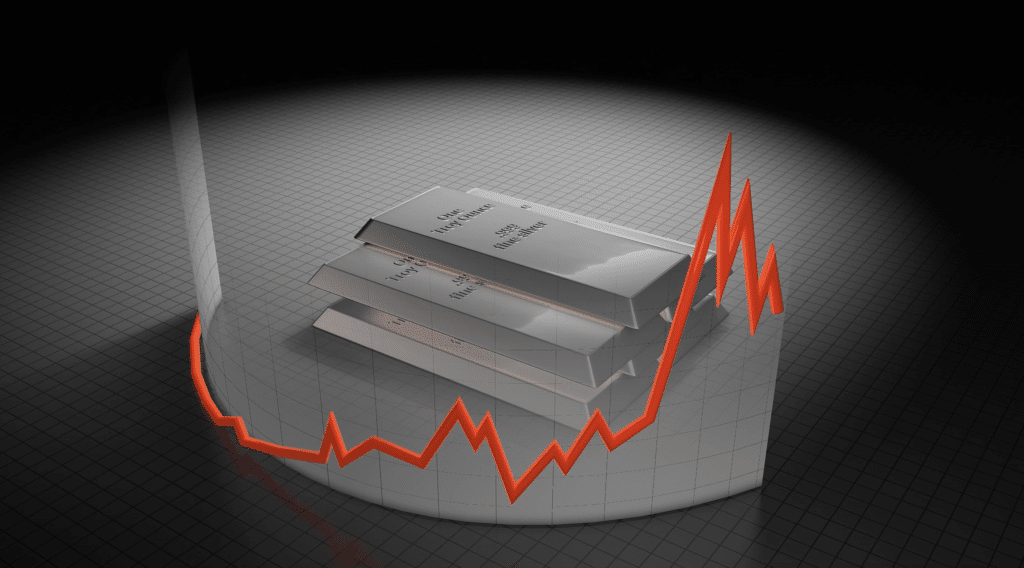When Was Silver Worth More Than Gold?

You've probably always thought gold is the king of monetary metals and silver is the ‘poor man’s gold, right? But what if I told you there was a time when silver outshined it? Shocking, isn't it?
There were, indeed, times in history when silver was worth more than gold. We will explore this subject by covering the following points:
- Silver Worth More Than Gold: A Historic Perspective
- The Gold-Silver Ratio
- Factors that Drive Silver's Price
- What Will Silver Be Worth in 10 Years?
- Silver and Gold Investing Through an IRA Company
In this article, you'll dive into history, discovering eras when silver was worth more than gold. You'll unveil what drove silver's value, how it was used, and the cultural symbolism it carried.
Get ready to challenge your perceptions and embark on an enlightening journey through the precious metals' past.
Silver Worth More Than Gold: A Historic Perspective
You've probably heard tales of times when silver was worth more than gold, and indeed, history confirms that there were several such periods. Ancient Rome, for instance, experienced a brief period when silver was more valuable than gold after acquiring large amounts of gold plunder. In the 19th century, Japan sought silver so eagerly that they exchanged gold for silver at a rate of one to three. The Soudan Arabs preferred silver to gold, suggesting a higher value for silver in their society.
The Old Kingdom Egyptians considered silver to be rarer and therefore more valuable than gold. This was also due to the absence of large silver deposits in the country and the need to import the precious metal. In ancient times, silver's allure and beauty often attracted people to exchange gold for it, despite the latter's higher value.
It is estimated, in the years 4400–3100 B.C.E, silver was used for fashion and status purposes, cult and ritualistic objects, and personal ornaments and adornments during the Predynastic Period of Egypt through Roman times. For much of Egypt's history, early temple inscriptions possibly suggest that silver was valued more highly than gold.
Sir William Ridgeway, in his book 'The Origin of Metallic Currency and Weight Standards', pointed out that silver must have been of higher value than gold at some point in all countries. However, as silver production increased, its value became equal to that of gold and eventually much less valuable.
The value of silver relative to gold fluctuated throughout history, marking periods where silver held higher value. The availability of historical documents discussing silver's value, in comparison to gold's value, underscores the significance of this topic. Factors such as the availability and accessibility of silver and gold deposits, metallurgical advancements, and the hoarding habits of countries, particularly during times of war, all shaped the relative values of these metals.
The Gold-Silver Ratio
Understanding the Gold-Silver ratio can deepen your knowledge of those historical periods when silver's worth overshadowed that of gold. This ratio, a metric that compares the price of an ounce of gold to that of silver, is crucial in assessing the comparative worth of these two precious metals.
For centuries, the ratio remained steady at approximately 15:1. However, in the 1900s, gold's price surged, causing a significant shift in this ratio.
Over the past 120 years, the Gold-Silver ratio has swung between 18 and 100, demonstrating the fluctuating nature of these metals' relative values. A higher ratio indicates a greater comparative value for gold. Various factors contribute to these fluctuations:
- Differences in supply and demand: The availability and need for gold and silver can affect their prices, and thus the ratio.
- Industrial usage: Both metals have significant industrial uses, impacting their demand and, subsequently, their price.
- Investment popularity: The perceived value and safety of gold and silver as investment assets can influence their prices.
Recently, the Gold-Silver ratio has seen extreme volatility due to the pandemic's impact, with mine closures affecting supply and a modern 'gold rush' driving up demand. The ratio spiked from 65 to 95 in 2022 alone. This stubbornly high ratio underscores how far silver would need to climb to reclaim its historical status. Although silver's value has increased, it's yet to surpass that of gold in the modern era.
Benefits of Working with a ReputableSilver and Gold Investment Company
When starting on the path of silver and gold investing, working with a credible and trustworthy precious metals vendor is key. Finding an established gold investment company that understands the many vacillations of the gold markets and the numerous variables affecting its price will save much time and hassle. Working with a reputable company with institutional knowledge can assist you with logical price entry points, positioning, and dollar-cost-averaging so you can maximize your investment capital.
Gold IRAs provide additional advantages to merely buying gold from a local dealer. Furthermore, these companies can provide serious gold investors access to competitive prices, transparency, a sound buyback policy, reliable customer service, and robust security protection of their precious metal investments.
Tap the banner below to visit Augusta Precious Metals to receive their gold IRA checklist
Factors that Drive Silver's Price
Understanding the factors that drive silver's price is crucial to grasping the metal's historical value relative to gold.
Consider the impact of fiat currency movements, industrial demand, silver deficit, and stock market instability on silver's price.
Also, don't overlook the role of geopolitical uncertainties in contributing to price volatility.
Fiat Currency and Economic Movements
To grasp how fiat currency and economic movements affect the price of silver, you must be aware of several key factors.
First, the strength of the U.S. dollar and Federal Reserve policies, particularly interest rates, significantly influence silver prices. Higher interest rates can make fiat currency more attractive, potentially decreasing demand for silver and lowering its price.
Secondly, industrial demand for silver plays a vital role. If this demand declines, silver's value may drop unless investment demand compensates for this dip.
Lastly, economic downturns often drive investors towards tangible assets like silver. If this shift in investment behavior is significant enough, it could cause silver prices to soar despite a decrease in industrial demand.
Each of these factors intertwines, shaping silver's price dynamics in complex ways.
Industrial Demand vs. the Silver Deficit
You might be surprised to know that several factors, including industrial demand and a silver deficit, can significantly drive silver's price.
Industrial use of silver has surged since 2012, particularly in consumer electronics, 5G infrastructure, and green technologies. The 2021 tech boom and remote work shift further boosted consumption by 9%.
Concurrently, pandemic-induced mine closures led to the first silver supply deficit since 2015. Although mining operations have since rebounded, the deficit persists, creating a delicate balance between supply and demand.
This interplay, coupled with silver's high industrial demand and limited supply, exerts substantial pressure on its price. So, while silver's value against gold has fluctuated throughout history, these factors continue to underscore silver's worth in today's market.
Stock Market Instability
Given these factors, it's crucial to consider how the instability of the stock market can further influence silver's price. The stock market's volatility often inversely correlates with silver prices. Meaning, that when stocks plummet, silver prices may stay steady or even increase.
This happens due to:
- Investors seeking safe-haven assets during market downturns
- Silver's industrial demand providing a buffer against price drops
- The lower price of silver compared to gold makes it more accessible to small investors
Price Volatility
With all these factors at play, it's clear that the price of silver is subject to significant volatility.
Supply and demand fluctuations, industrial usage, and investment popularity fundamentally drive silver's price. When industrial demand escalates, or supply tightens due to geopolitical or economic events, silver's price can skyrocket. Conversely, robust supply or diminished industrial demand can lead to price drops.
The strength of the U.S. dollar and decisions by the Federal Reserve also exert influence. Higher interest rates could make fiat currency more tempting, reducing silver demand.
Additionally, market speculation and investor sentiment play vital roles, often leading to rapid price changes.
As such, silver's price is profoundly affected by a complex interplay of various factors.
Geopolitical Uncertainty
Amid this volatile landscape, you must understand how geopolitical uncertainty can significantly impact silver's price. Precious metals like silver serve as safe havens during uncertain times. They provide a hedge against volatility and potential losses in other markets.
Tensions and conflicts around the globe often trigger a spike in silver's price as investors seek a refuge for their capital.
In contrast, periods of relative peace and stability can lead to a contraction in the silver market as investors turn their attention back to riskier assets.
Major geopolitical events, like wars or pandemics, can cause significant fluctuations in silver's price, demonstrating the metal's sensitivity to global uncertainty.
Understanding these dynamics can help you navigate the silver market more effectively.
Best Silver and Gold IRA for Low Minimum Investment
What Will Silver Be Worth in 10 Years?
Predicting what silver will be worth in 10 years is a bit like trying to hit a moving target, but you shouldn't let the uncertainty deter you from considering its potential. The value of silver is influenced by a multitude of factors, just as any other asset. Economic conditions, geopolitical stability, market speculation, and industrial demand all play a significant role in determining silver's worth.
Analysts, including those from the World Bank, forecast an average price of $21 per ounce through 2023. However, some have predicted that silver could reach as high as $92 per ounce by the end of 2027. While these predictions are based on current trends, unexpected events can cause significant fluctuations.
For example, should an economic downturn occur, demand for tangible assets like silver might increase, pushing up its price. Conversely, if interest rates rise, fiat currency could become more attractive, potentially decreasing demand for silver. Similarly, geopolitical events can cause significant shifts in silver's value, as investors often flock to precious metals as safe havens during periods of uncertainty.
Industrial demand also greatly impacts silver's price. Silver is widely used in electronics, photography, and jewelry. Advances in technology could lead to new uses for silver, potentially driving up demand and, consequently, its price.
While the precise value of silver in 10 years remains an enigma, its potential and resilience suggest that it will likely remain a valuable asset. But remember, investing always comes with risks, so it's essential to do your research and consider all factors before making a decision.
Silver and Gold Investing Through an IRA Company
Whether you are considering silver or gold as an investment asset for preserving purchasing power, hedging against inflation, as a portfolio diversifier, or building generational wealth, working with a long-established and trusted precious metals IRA company can provide access to competitive prices, transparency, a sound buyback policy, reliable customer service, and security of your precious metals.
Depending on whether you are a high-net investor looking for the most competitive prices or require a lower investment minimum and affordable entry to the gold market, we have researched and reviewed our best 4 gold IRA and precious metal investment companies that meet those individual needs. Whether you prefer a gold IRA or owning the physical gold that meets those individual needs.
Conclusion
So, there you have it. In certain historical periods, silver indeed commanded a higher value than gold. This was largely due to cultural values, scarcity, and industrial demand.
Today, the gold-silver ratio fluctuates, influenced by various market factors. Who knows? Maybe one day, silver might again outshine gold.
Keep an eye on these precious metals, as their stories continue to evolve over time.
Find the right company for you. Obtain a gold IRA guide and talk to a broker




If you have 100k in savings to protect and want to take advantage of the best prices, attend a gold educational webinar hosted by Augusta Precious Metals. Tap the button below:
Gold IRA FAQs

Adam ONeill
Author, lifelong investor, and creator of PreciousMetalsInvestmentPortfolio.com


